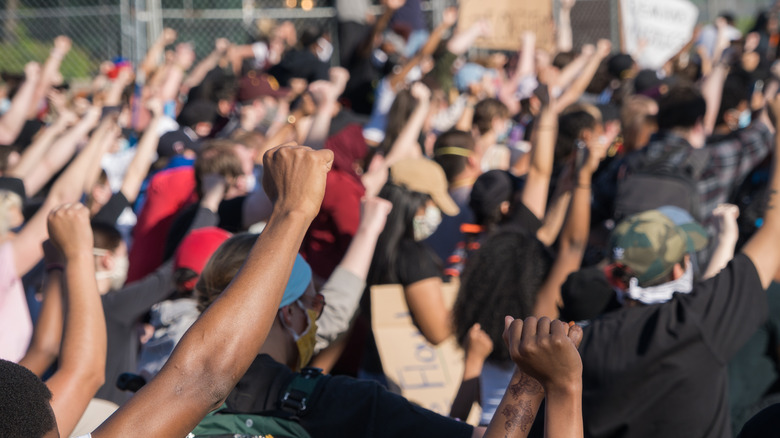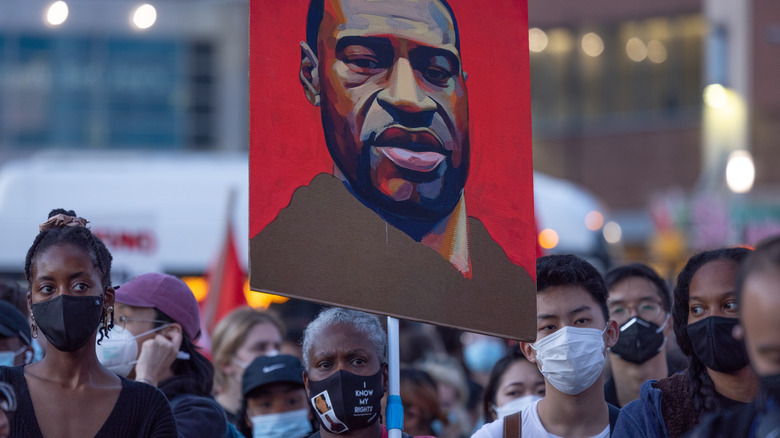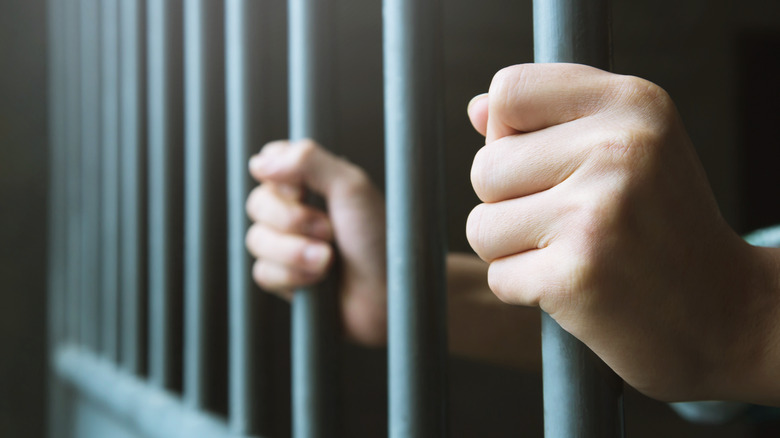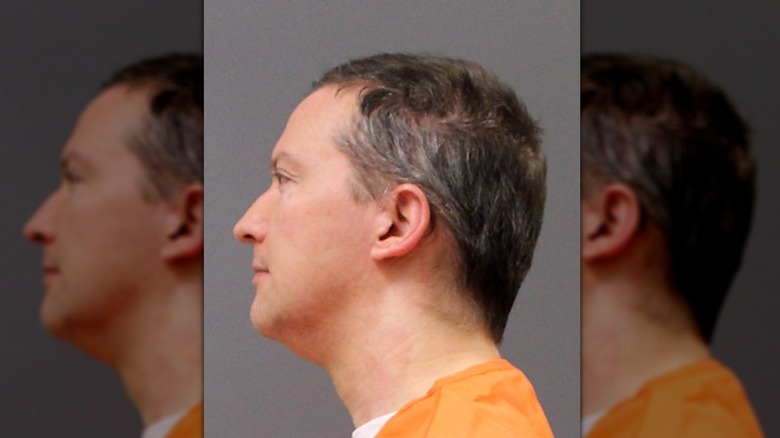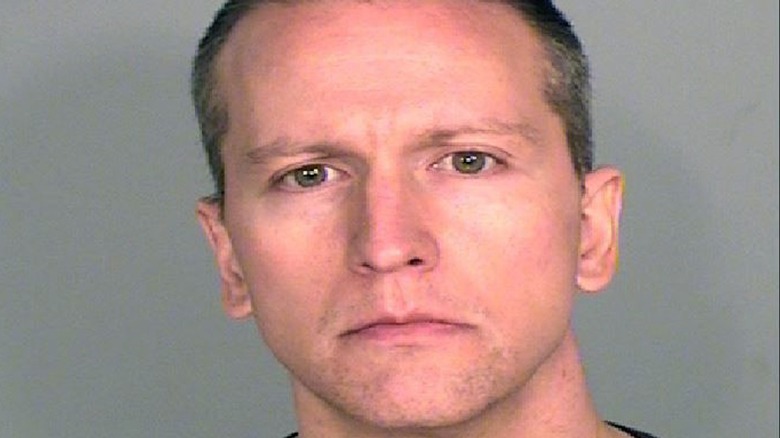What Derek Chauvin's Life In Prison Is Really Like
One of the seminal news events of the summer of 2020 was the death of George Floyd, an unarmed Black man who was killed in Minneapolis by then-police officer Derek Chauvin. Specifically, as CNN reported, Chauvin knelt on Floyd's neck for nearly nine minutes, even as Floyd continued to insist that he couldn't breathe. Just over a year later, Chauvin was sentenced to 22.5 years in prison for his role in Floyd's death, and according to Minnesota law, will spend at least 15 years behind bars before he's eligible for freedom. Chauvin appealed his conviction all the way to the Supreme Court, but they refused to consider the case in November 2023 (per The Guardian).
As a former police officer, and as a murderer at the center of an extremely high-profile crime, Chauvin was at risk of violence from other prisoners for not just one reason but two. As such, prison officials took great care to ensure his safety; Chauvin has spent most if not all of his time behind bars, up to this point, in a segregation unit safely away from other prisoners. But precautions went wrong shortly after Chauvin's failed appeal to the Supreme Court when, per AP, he was attacked by another inmate.
The murder of George Floyd garnered international attention
According to The New York Times, on May 25, 2020, Minneapolis police received a call from a convenience store about a man who was alleged to have purchased cigarettes with a counterfeit $20 bill. The man in question was 46-year-old George Floyd. When officers arrived on the scene minutes later, the situation escalated. Bystanders captured video of Chauvin kneeling on Floyd's neck even while Floyd pleaded with the officer to get off his neck so he could breathe.
The video of Floyd's death sparked international outrage. The day after the incident the Minneapolis Police Department fired all four officers who were on scene, and a few days later, it was announced that Chauvin was facing third-degree murder and second-degree manslaughter charges, with a second-degree murder charge being added later.
Chauvin was held in police custody for several months following his arrest, but received a conditional release in October 2020, per NBC News. Given the attention and the anger surrounding the case, a judge ruled that Chauvin was permitted to leave Minnesota, citing evidence of safety concerns that had been raised by the state's Department of Corrections.
Chauvin was initially held in segregation at a Minnesota prison
Following his arrest, according to Insider, Chauvin was housed at the Minnesota Correctional Facility at Oak Park Heights, where there was a segregation facility that could keep him safe from other inmates. Following his conviction, Minnesota authorities made the decision to keep him there, rather than move him to another facility, due to the fact that he required segregation and there was already such a unit there. "Since he was already at Oak Park Heights and was going to stay there, it would have not made sense to bring him up to [a different prison]," said a spokesperson at the time.
According to the Minnesota Department of Corrections website, "Administrative Control" facilities such as the one where Chauvin was housed are not always intended to be punitive but are also used to protect the inmates. In such facilities, they're checked on at least once every 30 minutes, are given regular mental health evaluations, and are allowed many of the same things other inmates are given, such as reading materials and personal correspondence, unless they're deemed to be a safety risk.
The Associated Press reported that his 10-foot-by-10-foot cell consisted of white cinderblock walls. There was a metal toilet and sink and narrow windows. Chauvin was allowed out alone to exercise for about an hour each day. He was also allowed up to three non-contact visits each week.
Chauvin requested to be moved to a federal prison
Chauvin pleaded guilty to federal charges he faced in the murder of George Floyd, but according to ABC News, he wanted a condition of his plea to be that he be incarcerated in a federal prison rather than a Minnesota state prison. This request meant that Chauvin is required to spend more time in prison, as the deal specified that the minimum time he had to spend behind bars in a federal prison was 20 years, as opposed to the 15 years he needed to spend in a state prison before being eligible for parole.
While this would seem like an unusual request, the feeling is Chauvin sought this option because it is typically accepted that federal prisons are safer than their state-level counterparts. Neama Rahmani, a former federal prosecutor, also noted overcrowding as a reason for the request. "There are many reasons for that. They're just managed better by the Bureau of Prisons, where state and local jails just are not," Rahmani said. In August 2022, Chauvin got his wish. Per CBS News, he was moved to Tucson Federal Prison in Arizona.
Chauvin was attacked by a fellow inmate
The federal prison Derek Chauvin was relocated to has a spotty record on security. The Associated Press reported (via Arizona Central) that a shooting incident, not long after Chauvin arrived at the facility, prompted a federal review of its safety. More questions were raised about security after November 24, 2023, when Chauvin was attacked by a fellow inmate and stabbed shortly after noon (per AP).
Initial reports out of Tucson did not name Chauvin but confirmed that an inmate had been attacked and required "life-saving measures" before transfer to a hospital. After his identity was confirmed, it was reported by KSTP-TV that Chauvin was stable and likely to survive the attack. Chauvin's lawyer, Eric Nelson, argued that the incident demonstrated why his client should have remained in isolation. But defense attorney Joe Tamburino told CBS News that the price of security in segregation is a "horrible [way] to serve your time." As of November 2023, it remains to be seen if Chauvin, who has reportedly acted as a model prisoner in Tucson, will be relocated again.
